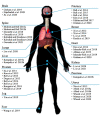Photoacoustic-guided surgery from head to toe [Invited]
- PMID: 33996218
- PMCID: PMC8086464
- DOI: 10.1364/BOE.417984
Photoacoustic-guided surgery from head to toe [Invited]
Abstract
Photoacoustic imaging-the combination of optics and acoustics to visualize differences in optical absorption - has recently demonstrated strong viability as a promising method to provide critical guidance of multiple surgeries and procedures. Benefits include its potential to assist with tumor resection, identify hemorrhaged and ablated tissue, visualize metal implants (e.g., needle tips, tool tips, brachytherapy seeds), track catheter tips, and avoid accidental injury to critical subsurface anatomy (e.g., major vessels and nerves hidden by tissue during surgery). These benefits are significant because they reduce surgical error, associated surgery-related complications (e.g., cancer recurrence, paralysis, excessive bleeding), and accidental patient death in the operating room. This invited review covers multiple aspects of the use of photoacoustic imaging to guide both surgical and related non-surgical interventions. Applicable organ systems span structures within the head to contents of the toes, with an eye toward surgical and interventional translation for the benefit of patients and for use in operating rooms and interventional suites worldwide. We additionally include a critical discussion of complete systems and tools needed to maximize the success of surgical and interventional applications of photoacoustic-based technology, spanning light delivery, acoustic detection, and robotic methods. Multiple enabling hardware and software integration components are also discussed, concluding with a summary and future outlook based on the current state of technological developments, recent achievements, and possible new directions.
© 2021 Optical Society of America under the terms of the OSA Open Access Publishing Agreement.
Conflict of interest statement
The authors declare no conflicts of interest.
Figures















Similar articles
-
Photoacoustic imaging for surgical guidance: Principles, applications, and outlook.J Appl Phys. 2020 Aug 14;128(6):060904. doi: 10.1063/5.0018190. Epub 2020 Aug 13. J Appl Phys. 2020. PMID: 32817994 Free PMC article.
-
Simulations and human cadaver head studies to identify optimal acoustic receiver locations for minimally invasive photoacoustic-guided neurosurgery.Photoacoustics. 2020 May 16;19:100183. doi: 10.1016/j.pacs.2020.100183. eCollection 2020 Sep. Photoacoustics. 2020. PMID: 32695578 Free PMC article.
-
Optical absorption spectra and corresponding in vivo photoacoustic visualization of exposed peripheral nerves.J Biomed Opt. 2023 Sep;28(9):097001. doi: 10.1117/1.JBO.28.9.097001. Epub 2023 Sep 4. J Biomed Opt. 2023. PMID: 37671115 Free PMC article.
-
Photoacoustic Imaging and Characterization of Bone in Medicine: Overview, Applications, and Outlook.Annu Rev Biomed Eng. 2023 Jun 8;25:207-232. doi: 10.1146/annurev-bioeng-081622-025405. Epub 2023 Mar 31. Annu Rev Biomed Eng. 2023. PMID: 37000966 Review.
-
AAPM and GEC-ESTRO guidelines for image-guided robotic brachytherapy: report of Task Group 192.Med Phys. 2014 Oct;41(10):101501. doi: 10.1118/1.4895013. Med Phys. 2014. PMID: 25281939 Review.
Cited by
-
The Dual-Targeted Peptide Conjugated Probe for Depicting Residual Nasopharyngeal Carcinoma and Guiding Surgery.Biosensors (Basel). 2022 Sep 5;12(9):729. doi: 10.3390/bios12090729. Biosensors (Basel). 2022. PMID: 36140113 Free PMC article.
-
Multispectral photoacoustic imaging of breast cancer tissue with histopathology validation.Biomed Opt Express. 2025 Feb 12;16(3):995-1005. doi: 10.1364/BOE.547262. eCollection 2025 Mar 1. Biomed Opt Express. 2025. PMID: 40109539 Free PMC article.
-
Miniaturized fiber optic ultrasound sensor with multiplexing for photoacoustic imaging.Photoacoustics. 2022 Oct 25;28:100421. doi: 10.1016/j.pacs.2022.100421. eCollection 2022 Dec. Photoacoustics. 2022. PMID: 36325305 Free PMC article.
-
Clinical photoacoustic/ultrasound dual-modal imaging: Current status and future trends.Front Physiol. 2022 Oct 19;13:1036621. doi: 10.3389/fphys.2022.1036621. eCollection 2022. Front Physiol. 2022. PMID: 36388111 Free PMC article. Review.
-
The emerging role of photoacoustic imaging in clinical oncology.Nat Rev Clin Oncol. 2022 Jun;19(6):365-384. doi: 10.1038/s41571-022-00615-3. Epub 2022 Mar 23. Nat Rev Clin Oncol. 2022. PMID: 35322236 Review.
References
-
- Manohar S., Vaartjes S. E., van Hespen J. C., Klaase J. M., van den Engh F. M., Steenbergen W., Van Leeuwen T. G., “Initial results of in vivo non-invasive cancer imaging in the human breast using near-infrared photoacoustics,” Opt. Express 15(19), 12277–12285 (2007).10.1364/OE.15.012277 - DOI - PubMed
Publication types
Grants and funding
LinkOut - more resources
Full Text Sources
Other Literature Sources
